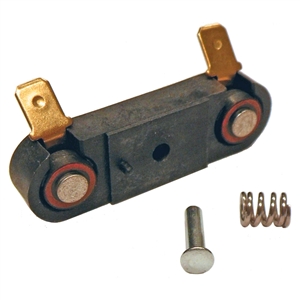"Alternatively you can also restore your original button diode rectifier assembly; if you don't have any damaged insulators or burnt diode holders since common 10mm 50A rated 400 peak reverse voltage button diode is available in varied quantities 2, 10, 25 but looking around, you can maybe buy them less then a buck a piece!
ref: 10mm button diode, I found this source looks decent for bulk pricing!
https://www.plpbattery.com/products/button-diode-10mm-40
This appears to be the common battery charger diode in most older chargers. I also contacted a local industrial battery shop contact; that confirmed they normally stock these button diodes so perhaps the quickest easy solution is half dozen or more button diodes and simply utilize the original rectifier assembly. If you simply verify polarity is correct on all diodes prior to applying any AC Power, theoretically in diagram shown previous "Negative Charging Cable" is connected directly to heat sink base! Both, "Secondary Leads" are connected to "two" insulated junction studs on heat-sink because the charger design is 6v, 12v thus you can visualize (3) x 50A Diodes in parallel top side and connected by "two" junction leads to "Each" of two "Secondary Leads" at top side insulated junction.
WARNING You Must Not have "Any" connection or Secondary Leads making direct or indirect short circuit contact with heat sink Base! CLEARLY UNDERSTAND the junction studs on the heat sink are fully insulated from the heat sink base. In theory the connection layout as illustrated provides 150A Maximum Current at each SECONDARY LEAD junction point and intended
"ONLY" for forward bias through all diodes
"IN CORRECT POLARITY!" Before any AC power is applied or connected; insure to test each individual diode tests "open" circuit in reverse polarity using Multi-meter Diode TEST function. If charger has "Boost" function selection this is considered only temporary 150A MAX
"intermittent duty cycle" purposes! THUS if you leave the charger in "Boost" for any extended either the diodes will short prematurely or the insulators on the Rectifier will suffer meltdown. Optimally I test from each secondary lead "junction" on rectifier attaching "one" test lead clipped at one junction and simultaneous testing correct polarity through each of three diodes on the "same bank" with other test lead on rectifier heat-sink base..(ALL THREE Paralleled DIODES) on
each secondary lead must be installed with same matching polarity when inserting the diode buttons; so you can test diode for correct polarity before inserting diode and after complete assembly. Worst case scenario you will only blow three diodes if polarity is incorrect or defect on one of the secondary outputs!
This is why they emphasize observing the polarity and testing prior to replacing the individual diodes! If your charger is tested before disassembly and you inspect the polarity and you match polarity of diodes as they are individually removed, tested, and replaced or reinstalled. There is no reason you should blow any diodes if you noted tested leads correspond matching polarity as intended by original design specification. I also perform final operation function output test (no load) using multi-meter DC VOLTAGE output test to insure correct polarity and "voltage" output to each battery output charging cable and insuring matching corresponding output battery cable clamp is correct as (Pos.) + from Ammeter = pos test lead and positive battery output cable, and (Neg.) - from Rectifier/ Circuit Breaker protection, attaching "negative test lead" at negative battery cable clamp output.
Test all functions and operation prior to attaching ANY LOAD! if you don't know how to fully test Transformer without "any" AC power INPUT attached then you should not attempt any repair or you should
"Always Follow the Manufacturers Original Design and Specification", Including the Schematic, which was provided only as an example of a similar design!


